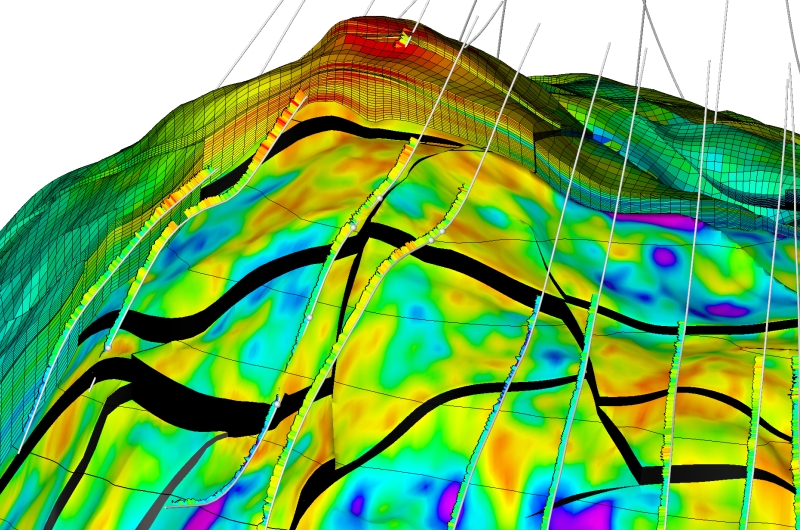Course Details
Home / Public Courses / Course Details
Reservoir Characterisation & Modelling Workshop (GEO14)
Description
This course is a practical about the design and construction of static reservoir models. It translates theoretical background into practical model construction using commercial modelling software.
Constructing a reservoir model includes the difficult task to integrate data from very different sources like seismic, well, core and wireline information as well as sedimentological concepts and facies interpretations. This course will show how modern reservoir modelling practice handles such different viewpoints from geoscience and engineering.
Throughout the course a reservoir will be characterised in terms of structure, sedimentology and related petrophysical properties and develops these into static reservoir models. Geostatistics and data integration across the key disciplines will set the baseline.
This training will focus on state-of-the-art concepts, practical fundamentals and common pitfalls when using applications in integrated computer-based modelling. It aims to provide a complete picture in reservoir modelling which starts already at the grid design. The bulk of the course will be used to convey detailed univariate and multivariate statistics, geostatistics and their applications. The modelling part will include variogram based and non-variogram based deterministic and stochastic techniques and show how to apply these for populating facies and properties like porosity, permeability or saturation.
During this workshop participants will construct a static geomodel, which is ready to be initialised as simulation model.
Course Level: Skill
Duration: 5 days
Instructor: Wilfried Gruber
Constructing a reservoir model includes the difficult task to integrate data from very different sources like seismic, well, core and wireline information as well as sedimentological concepts and facies interpretations. This course will show how modern reservoir modelling practice handles such different viewpoints from geoscience and engineering.
Throughout the course a reservoir will be characterised in terms of structure, sedimentology and related petrophysical properties and develops these into static reservoir models. Geostatistics and data integration across the key disciplines will set the baseline.
This training will focus on state-of-the-art concepts, practical fundamentals and common pitfalls when using applications in integrated computer-based modelling. It aims to provide a complete picture in reservoir modelling which starts already at the grid design. The bulk of the course will be used to convey detailed univariate and multivariate statistics, geostatistics and their applications. The modelling part will include variogram based and non-variogram based deterministic and stochastic techniques and show how to apply these for populating facies and properties like porosity, permeability or saturation.
During this workshop participants will construct a static geomodel, which is ready to be initialised as simulation model.
Course Level: Skill
Duration: 5 days
Instructor: Wilfried Gruber

Designed for you, if you are...
- A geologist, geophysicist or petroleum engineer seeking to gain an understanding and practical knowledge in reservoir characterisation, geostatistics and modelling
How we build your confidence
- Emphasis will be on practical examples in order to improve personal skills in reservoir modelling
- At the same time, theory in statistics, geostatistics, interpolation and simulation techniques will be communicated to provide a firm knowledge base
- The course is designed in a way that each main topic will consist of a theory section followed by computer exercises for application of the learned and opportunities for in-depth discussions
The benefits from attending
At the end of the course, you will have confidence on setting up a reservoir modelling strategy and operating a reservoir modelling software package through all steps of model building.The key points to take will be:
- Showing the methods and benefits of integrating geological, geophysical, petrophysical and engineering data into static reservoir models
- Introducing state of the art deterministic and stochastic modelling techniques, demonstrating their application and outcomes
- Gaining skills on making realistic assumptions of reservoir parameters and the associated spread of model uncertainties
- Discussing the full workflow from data input and analysis through modelling and upscaling results into a model ready for flow simulation
Topics
- Introduction to reservoir characterisation
- Reservoir metrics and related variable types
- Generation of a reservoir model
- Grid design and structure determination
- Structure model exercise
- Geostatistics and spatial data analysis
- Statistics exercise
- Variograms, Kriging basics and methods, Co-kriging
- Kriging exercise
- Stochastic simulation methods for discrete variables (indicator simulation, TGS, Boolean, MPS, etc.)
- Simulation methods for continuous variables (SGS, GRFS, bivariate, etc.)
- Facies, properties and fracture modelling strategies
- Exercise on stochastic simulation
- Volume estimates and uncertainty assessment
- Upscaling to coarse grid models
- Exercise on volumes and upscaling
Related Courses
Customer Feedback
"The packing and the quality of the manual is the best I have seen, the instructor is really good and expert and he is really efficient in terms of time. " - Reservoir Geologist at ADCO© All rights reserved
HOT Engineering GmbH Tel: +43 3842 43 0 53-0 Fax +43 3842 43 0 53-1 hot@hoteng.com
